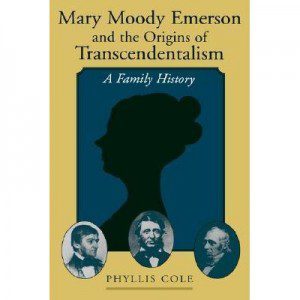This post is a continuation of my previous post on Mary Moody Emerson: Ralph Waldo’s “First & Best Teacher”
Mary’s independence kept her from being fully comfortable in  either the traditional orthodox camp or the new more progressive Transcendentalist movement of her nephew. She was too innovative and free-spirited to be fully comfortable among Calvinists, but there were aspects of traditional Christian theology that she continued to value that kept her from fully embracing her nephew’s Transcendentalism. In many ways, “she belonged to both sides and neither” (102). This dynamic contributed to a growing divide between Mary and Waldo. But even as the two were never as close in later years as they were in Waldo’s childhood and young adulthood, her Almanack continued to influence him (201-205).
either the traditional orthodox camp or the new more progressive Transcendentalist movement of her nephew. She was too innovative and free-spirited to be fully comfortable among Calvinists, but there were aspects of traditional Christian theology that she continued to value that kept her from fully embracing her nephew’s Transcendentalism. In many ways, “she belonged to both sides and neither” (102). This dynamic contributed to a growing divide between Mary and Waldo. But even as the two were never as close in later years as they were in Waldo’s childhood and young adulthood, her Almanack continued to influence him (201-205).
I’ll share just one famous story from near the end of Mary’s life. One evening, Bronson Alcott was hosting a conversation on the topic of “Private Life” at Waldo’s house, while Waldo was away lecturing. Among those present in addition to Mary were Henry David Thoreau, his sister Sophia, and other usual suspects from Transcendentalist circles. When one man in attendance proceeded to hijack the conversation and pontificate about moral relativism in a way such that neither Alcott nor Thoreau could mitigate, Mary intervened. Here’s a description of what ensued, as recorded by the journalist Franklin Sanborn, who was also part of Transcendentalist circles:
Rising from her chair at the west side of the room, and turning her oddly-garnished head toward the south side, where the offender smilingly sat, she clasped her little wrinkled hands and raised them toward the black band over her left temple (a habit she had when deeply moved), and began her answer to those doctrines of Satan, as she thought of them. She expressed her amazement that any man should denounce the Moral Law—the only tie of society, except religion, to which, she saw, the speaker made no claim. She referred him to his Bible and to Dr. [Samuel] Clarke (one of her great authorities from childhood) and she denounced him personally in the most racy terms. She did not cross the room and shake him, as some author, not an eye-witness has fancied—but she retained her position, sat down quietly when she had finished, and was complimented by the smiling [target of her words], who then perhaps for the first time had felt the force of her untaught rhetoric. (294-5)
She may have been unschooled in formal rhetoric, but a lifetime of independent inquiry, reading and conversation had made her a formidable intellectual interlocutor.
In her final years, Mary become increasingly involved in the Abolitionist movement. Both the anti-slavery movement and women’s leadership in that movement gave her new hope for an increasingly equal role for women in the future (268). And although Mary grew increasingly ill, she was likely well enough on New Year’s Day 1863 to comprehend the sea change of President Lincoln’s Emancipation Proclamation taking effect. Mary died a few months later on May 1, 1863 at the age of 88 (305).
Six years after Mary’s death, when Waldo himself was sixty-five and near the end of his public speaking career, one of the last lectures he ever wrote was in her honor. He titled it “Amita,” which is Latin for “aunt.” (3-4). Years earlier he had written a series of biographical essays on Representative Men, meaning exemplary archetypes of their time and place. At that time, all his examples were famous European men. With “Amita,” he expanded his scope to include Mary:
It is a representative life, such as could hardly have appeared out of New England; of an age now past, and of which I think no types survive. Perhaps I deceive myself and overestimate its interest. It has to me a value like that which many readers find in Madam Guyon, in Rahel [Varnhagen], in Eugénie de Guérin, but it is purely original and hardly admits of a duplicate. Then it is a fruit of Calvinism and New England, and marks the precise time when the power of the old creed yielded to the influence of modern science and humanity. (3)
Here we see Waldo putting Mary in the same class as three famous independent, intellectual women: a heretical French mystic, a German-Jewish letter-writer and saloniste, and another French mystic known—as Mary was—primarily through her journals and letters.
And Waldo was far from Mary’s only public admirer. Elizabeth Peabody also expressed her esteem for Mary. Elizabeth both celebrated that Waldo had extended the Emersonian talent inherited from his aunt, and lamented that Mary’s talent remained buried in many ways due to her gender. In 1910, a young Virginia Woolf, only in her late twenties at the time, also became aware of Mary’s genius and influence on Waldo. Woolf incorporated this insight in her study of the “Creative life and domestic contraction of women” (6-7).
On this week following Mother’s Day, the life of Mary Moody Emerson is an invitation to honor those of our foremothers who taught us to question received tradition and to pay attention to the wisdom of our own firsthand experience.
The Rev. Dr. Carl Gregg is a certified spiritual director, a D.Min. graduate of San Francisco Theological Seminary, and the minister of the Unitarian Universalist Congregation of Frederick, Maryland. Follow him on Facebook (facebook.com/carlgregg) and Twitter (@carlgregg).
Learn more about Unitarian Universalism: http://www.uua.org/beliefs/principles
















